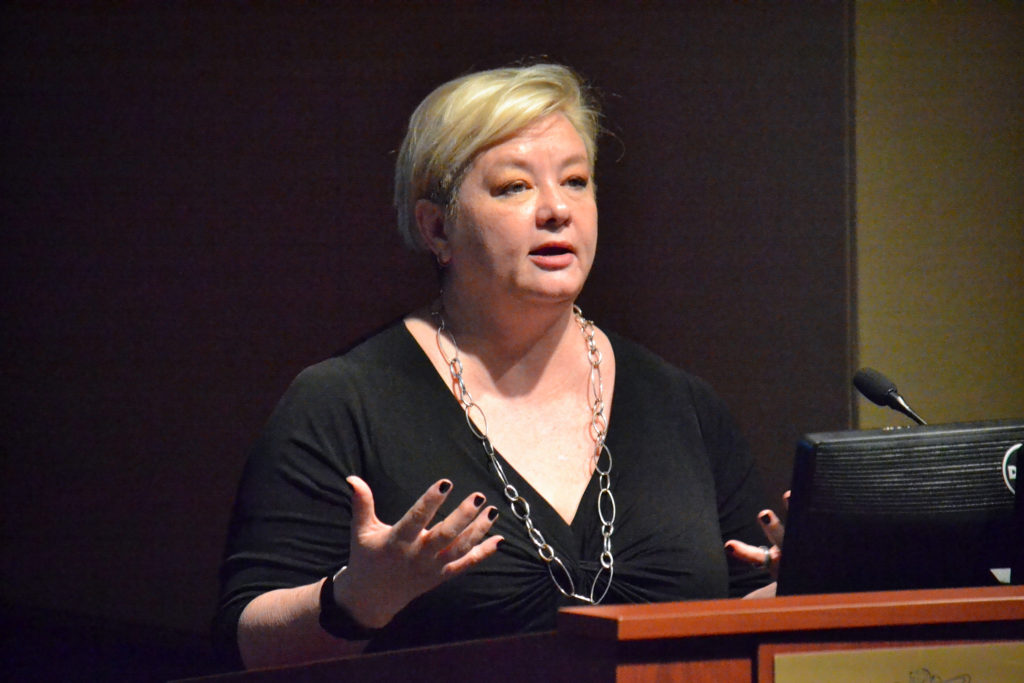By Michael Battista
Staff Writer
The Women’s and Gender Studies Department kicked off Women’s History Month on March 8 with a lecture entitled “Tweet Storm: The Rise of Trump, the Mainstreaming of White Nationalism and the Real Threat to Building just and Sustainable Communities.”
Jessie Daniels, a sociology professor at Hunter College and sociology and psychology professor at The Graduate Center, CUNY, led the event, which fell on International Women’s Day, and discussed the rise and sustained presence of white nationalism in sustainable, non-racially or sexually segregated communities within the country.
As the first part of the event’s title suggests, Daniels looked back at the election of President Donald J. Trump. Later that week, for example, white supremacists like Richard Spencer, of the now famous “Nazi Punch” video, were heard chanting and shouting phrases like “Hail Trump!”

This sort of rise to power was aided by Trump’s use of false, racially biased statistics on topics such as black-on-black crime in the U.S. and murder rates by other minorities, according to Daniels. She said false information like these statistics led Dylann Roof to shoot up a church in Charleston, S.C., in 2015 because he felt black people “were raping our women.”
“People’s lives are at stake because of these kinds of false statistics,” Daniels said.
In an interview with The Signal, Daniels said she hoped the audience understood that Trump is an example of modern white supremacy from her presentation.
“I wanted to talk about how the current president is really an example of something that I’ve been studying for a long time,” Daniels said. “I’ve been studying white supremacy’s various manifestations, in print and online, and one of my main arguments is that white supremacists’ rhetoric is very connected to the mainstream of political discourse, and in many ways Trump is exhibit A of what I’ve been talking about for 25 years.”
To help understand how this all came about in the U.S., Daniels used the example of a woman at an Alt-Right meeting who was interviewed by journalists. The woman, named Emily, said she hated herself after reading “To Kill a Mockingbird” for a school project.
“‘I hated myself my whole life because I was white, ever since I was 11 years old and the guilt was just piling on,’” Daniels read off her powerpoint, quoting Emily.
This all changed, however, once she learned about white nationalism: The idea that white people are their own race and have their own white national identity. The guilt went away and she became more empowered.
Daniels used examples from her books “White Lies” (1997) and “Cyber Racism” (2009) that further explained the phenomenon. She said that over time, white nationalism disguised itself and found residence within the mainstream. Some believe that white nationalism is gendered down to it’s core beliefs, but remains similar enough to mainstream rhetoric about race and gender.
She defined terms such as white nationalism and white supremacy, and helped connect it to things people may see in everyday life such as the role of women as mothers or men as the breadwinners.
Daniels said male white supremacists see others, including white women, in roles that are not as crucial to the workforce. They believe white men built the country while women were building the family among other smaller tasks.
As this ideology has grown, the news media has been able to bring in viewers from examining and showing off these ideas, according to Daniels. Appearances of white supremacists on shows such as Geraldo Rivera’s talk show and replays of racially charged messages from Trump’s rallies have helped TV networks’ ratings.
“‘It may not be good for America, but it's damn good for CBS,’” Daniels said, quoting CBS Chairman Les Moonves.
Daniels said this tactic allows the media to appear that they are not white supremacists.
“What news media is doing there is they’re distancing themselves both from the white supremacists and from Geraldo,” Daniels said. “And what that does is it lets news media… off the hook when it comes to examining their own white supremacy.”
As this integration has become more commonplace, so has hate speech within the public eye. Some websites, which Daniels labeled “cloaked websites,” are able to trick web viewers into visiting by appearing to provide information they want. In reality, the site only contains hate-induced propaganda that may undermine racial and social accomplishments that the U.S. has achieved over the last century, according to Daniels.
Websites like martinlutherking.org, which is hosted by the white nationalist forum stormfront.org, help move the idea that there are “two sides to every story,” Daniels said. That is the ultimate goal of white supremacists — to have their voices heard.
As the presentation went on, Daniels answered questions from the crowd, and the ideas circulating still proved this is a major issue.
“I think it’s important because… I think people’s lives are at stake,” Daniels said. “When the policies of our government are based on this entrenched system of white supremacy, then people die because of it, and it’s not a random distribution of people in the population that die — it’s disproportionately people of color, it’s immigrants, it’s poor people.
“And that’s part of what Trump’s policies are enacting,” she added. “That system of white supremacy where, again, we have white people systematically benefitting and people who are racialized as other (are) systematically at a disadvantage. And there’s something inherently wrong with that, and we have to pay attention to it.”







